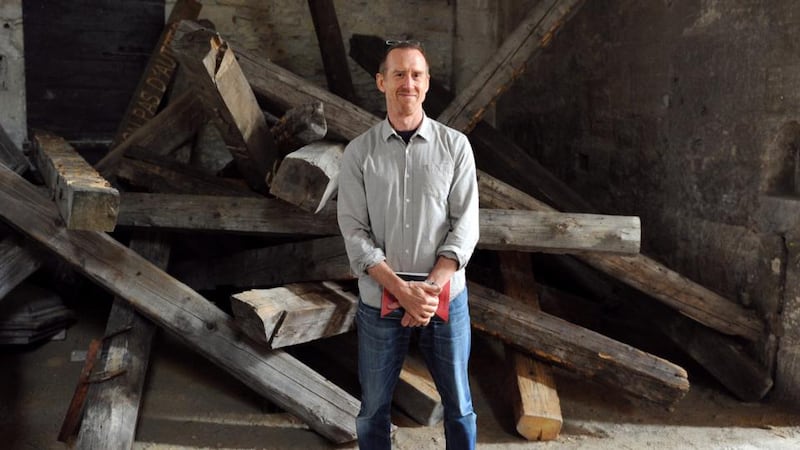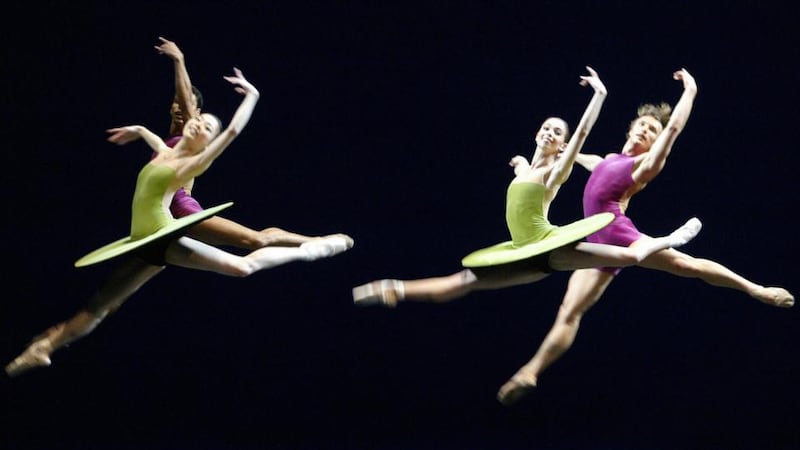During the process of decommissioning arms after the Belfast Agreement, in 1998, the word choreography was central to the political lexicon. Politicians, journalists and White House staff used the term to describe the intricate dance of gestures by both sides of the Northern Ireland conflict.
They, like many others, found it a useful metaphor, a way, in their case, to describe the sequence of concessions that helped to end the Troubles. In recent years choreographers have been thinking about that type of process in reverse – about how to apply the workings of the dance studio, and the notion of “physical thinking”, to other disciplines.
Foremost among them has been the American-born choreographer William Forsythe, who has influenced visual artists, architects and designers, challenging fundamental assumptions about choreography and dance along the way.


Irish audiences will be able to observe some of these ideas performed by two Forsythe Company dancers, Jone San Martin and Josh Johnson, in Legítimo/Rezo, at Project Arts Centre, in Dublin, on Saturday.
"Legítimo/Rezo offers a great insight into Forsyth's creative process," says John Scott, artistic director of Irish Modern Dance Theatre, who produced the performance with Project, supported by the Goethe-Institut. "Jone shows extracts of his works and phrases and demonstrates the systems and methods that turn a dance phrase or series of movements into a higher, beautiful work of art."
Forsythe, who was born in New York in 1949, was a latecomer to dance; he began formal ballet training only in his late teens. His choreographic career took off when he moved to Germany to join Stuttgart Ballet, whose founder, John Cranko, also encouraged choreographers such as Jirí Kylián and John Neumeier. When Forsythe was appointed artistic director of Frankfurt Ballet, in 1984, he popularised ballet by creating works that were hugely ambitious in scale and challenged theatrical convention – at one point in Artifact, his first work for Frankfurt Ballet, the dancing is deliberately interrupted by the theatre's safety curtain repeatedly rising and thudding down.
After that troupe’s funding was cut he set up the smaller Forsythe Company, in 2005, to continue his restless investigations into choreography. More recently he has created installations for the Venice Biennale, in Italy, and the Louvre, in Paris.
"From the very beginning of his dance career he was thinking about dance intellectually," says Steven Spier, editor of the book William Forsythe and the Practice of Choreography. "Ballet, and more broadly dance, struggles to be taken seriously as an art form. He helped open up the idea that dance should deal with the same issues that other art forms deal with. That was really controversial, saying it's not just about steps or a nice evening out."
Central to this is challenging the way a choreographer works. In some dances Forsythe credits the company with the choreography, or uses improvisational methods, rather than acting as the master who creates steps for the dancers to perform.
“There is an academic field within dance, but it is unusual for a choreographer to be so successful by working in an intellectual way,” says Spier. Forsythe’s dances are now in the repertoires of the world’s most important ballet companies, but according to Spier his influence goes beyond these works. “His invigoration of ballet has been really profound. His ideas meant a lot of choreographers stayed with ballet and created the room for talents like Wayne McGregor, a resident choreographer of the Royal Ballet who has delivered a Ted Talk on choreographic process.” Forsythe’s influences include mathematics, ancient literature and cognitive science. “He believes that everything has a potential influence over dance. That is how contemporary artists think. This rich, complicated world can come back through your art form.”
John Scott experienced Forsythe’s methods first hand in 1997 when he observed three weeks of Frankfurt Ballet rehearsals. “His sense of composition, structure, phrasing and technique is virtuosic and breathtaking,” says Scott. “He would make a few shifts and turn an already beautiful, complex dance phrase into something deep, unpredictable and multidimensional.”
It’s not just dancers who are attracted to Forsythe’s methodology. “Architects really like his dances,” says Spier, who is dean of the faculty of art, design and architecture at Kingston University, in London. One of Spier’s main research interests is now choreography as a spatial organising system. But the human, emotional side of dance is important to him, too; although Spier was initially impressed by the structure of Forsythe’s work he was also moved. “That is the important thing about his work,” he says. “It is not medicine.”
Jone San Martin, who performs Legítimo/Rezo, says that the dance isn't a dry academic exercise. Yes, she and Josh Johnson have a conversation through dance about Forsythe's choreographic process, but the solo that follows is playful and can border on the irreverent. During that dance she wears headphones through which Johnson feeds audio material she has never heard before. This, along with different theatre layouts, keeps the performance fresh, but the audience are the biggest influence.
"I can judge how receptive they are during the dialogue with Josh and react by adjusting my solo dancing accordingly," she says. How, exactly? "Well, sometimes I say thank you and sometimes I say f**k you." San Martin played the mother in Three Atmospheric Studies when the Forsythe Company performed at the Abbey Theatre during the 2008 Dublin Dance Festival.
In April, Jacopo Godani will become the Forsythe Company's artistic director, as Forsythe moves on to become associate choreographer at Paris Opéra Ballet. "It shows that he still sees that there is something still worth exploring in ballet," says Spier.
Among the dance artists who have explored Forsythe's notion of physical thinking is his fellow choreographer – and former artistic consultant – Michael Kliën. When he was artistic director of Daghdha Dance Company, in Limerick, Kliën linked dance with contemporary art by setting works at the Irish Museum of Modern Art. (His installation Slattery's Lamp is in its permanent collection.) He also based Silent Witness/A Dancing Man, a solo performance at Imma in 2001, on his time observing the systems and structures of the Dáil.
Kliën’s solo, like Forsythe’s public installations, might be a relatively small artistic statement, but it shows how choreography is increasingly used as another way to express or question our social interactions.
In the more intimate space of Project Arts Centre, the audience – whether dancers, architects or, indeed, politicians – can witness Forsythe's ideas up close. "The French dance writer Philippe Noisette tweeted to me that Legítimo/Rezo shows us not only how to be a Forsythe dancer but how to be a Forsythe spectator," says Scott. "For anyone interested in dance, they will get a chance to see the nuts and bolts of the greatest living master of dancemaking."
Legítimo/Rezo is at Project Arts Centre, Dublin, on Saturday at 8pm













